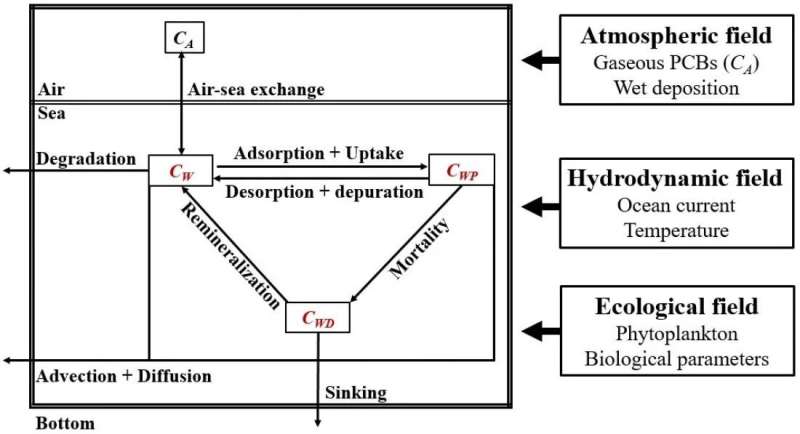The Kuroshio current regulates the air-sea exchange of PCBs in the open ocean: Study

Air-sea diffusion flux is the main source of polychlorinated biphenyls (PCBs) in the open ocean. The oceanic biological pump, current advection, and eddy diffusion affect the distribution of PCBs in the ocean surface and thus affect the air-sea diffusion flux.
The biological pump means the uptake of dissolved PCBs in sea water by phytoplankton and subsequent export to the deep ocean by sinking particles. The ocean current brings the water with different concentrations of PCBs from a remote area and therefore changes the local concentration of PCBs; the eddy diffusion acts to reduce the spatial gradient of the concentration of PCBs.
Western boundary currents, with a width of 100–200 km, flow close to the land. Because of the close distance to the land, the high emission over land results in a high gaseous concentration of PCBs over these western boundary currents. Consequently, these currents may have a high dissolved concentration of PCBs and gradually release PCBs into the air as they flow far away from the land. Therefore, these western boundary currents may play an important role in the global air-sea exchange of PCBs.
In this new work, published in Environmental Science & Technology, a three-dimensional hydrodynamic-ecosystem-PCB coupled model was developed for the northwestern Pacific Ocean (NWPO) to simulate the transport and biological processes of four PCB congeners.
In this model, a high-resolution hydrodynamic model (1/12°) was used to reproduce a realistic western boundary current; a full coupling ecosystem module was used to represent the biological pump effect on PCBs; the results of an atmospheric model of PCBs were used as the surface boundary condition to analyze the spatial and temporal variations in the oceanic PCBs concentration.
The model revealed a fine structure in the air-sea flux that is sensitive to the presence of ocean currents, especially the Kuroshio. Intense downward and upward diffusion fluxes can be found in the Kuroshio region south of Japan and the Kuroshio Extension east of Japan, respectively. The sensitivity experiments indicated that it takes ~4 days in the strong western boundary current region and 1~3 days in the weak current regions for the surface dissolved PCBs concentration to reach an equilibrium in the scenarios where only air-sea exchange is considered.
On the other hand, the equilibrium time of surface dissolved PCBs concentration becomes ~1 day in the strong western boundary current region and 3~12 days in the weak current regions in the scenario where only ocean advection is considered. Therefore, the surface dissolved PCBs concentration in weak current regions is mainly controlled by the air-sea exchange because the air-sea exchange has a shorter equilibrium time than ocean advection does.
For the same reason, the surface dissolved PCBs concentration in the western boundary current region is mainly controlled by the ocean advection, indicating that dissolved PCBs from upstream carried by the Kuroshio can easily change the dissolved concentration downstream by disrupting the equilibrium with the original air-sea exchange and induce a new air-sea flux.
Current global fate simulations for PCBs are mostly based on multimedia models, whose oceanic compartment is simplified to a box model that ignores the direct effect of ocean current advection on PCBs, and those global models with a horizontal resolution of ~100 km are too coarse to reproduce the realistic western boundary currents.
Therefore, the effects of western boundary currents on PCBs concentrations have not been fully considered by the global ocean simulation of PCBs. One important implication is that the effect of western boundary currents on the air-sea diffusion flux of PCBs should be considered in atmospheric modeling of the global distribution and fate of PCBs.
More information: Min Yang et al, The Kuroshio Regulates the Air–Sea Exchange of PCBs in the Northwestern Pacific Ocean, Environmental Science & Technology (2022). DOI: 10.1021/acs.est.2c03459
Journal information: Environmental Science & Technology
Provided by Ehime University





















